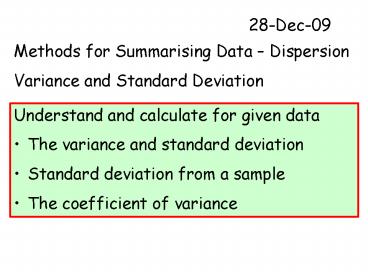Methods for Summarising Data Dispersion PowerPoint PPT Presentation
1 / 20
Title: Methods for Summarising Data Dispersion
1
28-Dec-09
Methods for Summarising Data Dispersion Variance
and Standard Deviation
- Understand and calculate for given data
- The variance and standard deviation
- Standard deviation from a sample
- The coefficient of variance
2
Variance and Standard Deviation These are
measures of how the data differs from the mean
For data sets 6, 7, 7, 7, 16, 17 (Mean 10)
and 2, 3, 7, 8, 10, 30 (Mean 10)
3
There is a problem in finding the totals of the
deviations because ?deviations 0. This is due
to the negative and positive values cancelling.
4
This is overcome by squaring the deviations and
the mean of the sum of the square of all the
deviations from their mean is called the VARIANCE.
Variance 128 6 21.7
Variance 526 6 87.7
5
STANDARD DEVIATION This is the positive square
root of the variance
Variance 128 6 21.7 S.Dev. ? v21.7 4.7
Variance 526 6 87.7 S.Dev. ? v87.7 9.4
6
Standard Deviation
Standard Deviation s s v(?(x µ)2) n x is
data µ is the mean ? 10 n is total frequency ?
6 s v128 6 s v21.3 s 4.7
s v(?x2) n µ2 s v728 6 100 s
v21.3 ? s 4.7
A more usable rule is s v(?x2) n µ2
7
s v(?(x µ)2) n Or much more usable s
v(?x2) n µ2 s ? S.D. µ ? mean n ?
total freq.
You need to know these
8
Find the estimated mean and standard deviation
9
(No Transcript)
10
Estimated Mean µ 950 40 µ 23.75
11
Estimated Mean µ 950 40 µ 23.75
12
Standard Deviation s v(?F(x µ)2) n s
v1228 40 s 5.5
Estimated Mean µ 950 40 µ 23.75
13
(No Transcript)
14
(No Transcript)
15
(No Transcript)
16
Standard Deviation s s v(?fx2) n - µ2
s v(?f(x2) n µ2 s v(23790 40
23.752) s 5.5
17
If the data is a sample of a given population,
then the mean will be the sampler mean and this
is denoted as bar x x with a bar on top
x In this case the standard deviation will be
18
s v(?(x x)2) (n 1) or s v(?x2) (n
- 1) x2 s ? S.D. x ? sampler mean n ?
total freq.
Sample
You need to know these
19
s v(?(x µ)2) n or s v(?x2) n
µ2 s ? S.D. µ ? mean n ? total freq.
Complete data set
You need to know these
20
Coefficient of Variance To compare the spreads
of data, use the coefficient of variance. This
gives a percentage and the greater spreads will
have higher percentages. V (100 x s) µ or
for samples V (100 x s) x
For our original data
6, 7, 7, 7, 16, 17 and 2, 3, 7, 8, 10, 30
V 100 x 4.7 10 V 47
V 100 x 9.4 10 V 94

